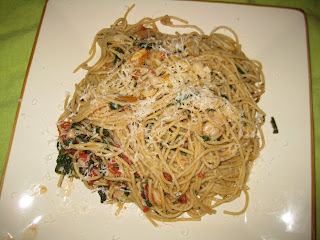Whole Wheat Pasta with Greens, Beans, Tomatoes, and Garlic Chips
Before I get started on the recipe, I am a messy cook. OMG, it is ridiculous. I make the biggest messes. Food is dropped on the stove, the counters, the floor, everywhere. I usually have to sweep the floor after cooking. I think part of the reason is my novice kitchen, but that is another issue.
So on to the recipe. And this was adapted from Cooks Illustrated, which is obviously for more skilled chefs than I, but it has garlic in the title so it is worth trying.
- 3 tablespoons olive oil
- 8 cloves garlic, 5 cloves sliced thin lengthwise, 3 cloves minced or pressed through a garlic press (1 tablespoon) Example 1: sophistication, garlic press really
- Table salt
- 1 medium onion, diced small (about 1 cup)
- 1/2 teaspoon hot red pepper flakes
- 14 cups kale (loosely packed) or collard greens (1 to 1 1/2 pounds), thick stems trimmed, leaves chopped into 1-inch pieces and rinsed, water still clinging to leaves
- 1 1/2 cups low-sodium chicken broth
- 1 can (14 1/2 ounces) diced tomatoes, drained
- 1 can (15 ounces) cannellini beans, drained and rinsed
- 3/4 cup pitted kalamata olives, roughly chopped
- 13 1/4 ounces whole wheat spaghetti
- 2 ounces Parmesan cheese, finely grated (about 1 cup), plus additional for serving
- ground black pepper
Directions
Heat oil and sliced garlic in 12-inch straight sided saute pan over medium-high heat. Cook, stirring and turning frequently, until golden brown, about 3 minutes. Using slotted spoon, transfer garlic to paper towel lined plate. Sprinkle lightly with salt. (Ok, really, am I supposed to know what kind of saute pan I have. And honestly does it really matter.)
Add onion to pan; cook until starting to brown, about 5 minutes. Add minced garlic and red pepper flakes; cook, stirring constantly, until garlic is fragrant, about 30 seconds.
Add half of greens to pan; using tongs (which I do not have and realize I need), toss occasionally, until starting to wilt, about 2 minutes. Add remaining greens, broth, and 3/4 teaspoon salt; cover (pan will be very full); increase heat to high and bring to strong simmer. (What does that mean?) Reduce heat to medium and cook, covered, tossing occasionally, until greens are tender, about 15 minutes (mixture will be somewhat soupy). Stir in beans, olives, and tomatoes.
Meanwhile, bring 4 quarts water to boil in Dutch oven (what that what? can't you just use a pot? well I did and it worked fine.) over high heat. Add spaghetti and 1 tablespoon salt; cook until pasta is just shy of al dente. Drain pasta and return to pot. Add greens mixture to pasta, set over medium-high heat, and toss to combine. Cook until pasta absorbs most of the liquid, about 2 minutes. Stir in 1 cup Parmesan; adjust seasoning with salt and pepper. Serve immediately, passing garlic chips, extra-virgin olive oil, and Parmesan separately. (You should start the pasta at the beginning of preparation.)
Notes:
- I used spinach instead of kale or collards. I used 2 10 ounce packages of spinach. I don't know what it equaled loosely packed, but it is resulted in plenty of spinach for the recipe.
- I used vegetable broth instead of chicken.
- I used 28 ounces of 14 and I am glad I did. The Hubs always complains about pasta that is not "saucy" as he calls it. So hopefully this will be enough.
- I did not use the kalamata olives. I love them, but the Hubs is not a big fan, so to make it easy I left it out. I did not miss them in the recipe.
- I did not have to add any salt and pepper for taste in the end. It was full of flavor.
Verdict:
I loved this recipe. It was so yummy. The mixture of beans, spinach, tomatoes, and yum garlic was delicious. Add some Parmesan cheese and the garlic chips on top and this is a bomb diggity meal. I just hope the Hubs loves it as much because I definitely want to add this to our regular rotation. I am glad it was serve immediately because I was starving. Hopefully it will taste just as good heated up.
Updated with the Hubs' reaction: He loved it too. Yeah. He ate dinner after I did and I was sitting watching tv while he was eating. He was making all these sounds, like, mmm, mmm...so he must have thought it was good. Definitely adding this to the list of repeats.
 What is that lingerie? How much money does she have for a clothing allowance? And this is what she chooses. Where are her people to tell you "umm no honey, uh uh. Not this time. Keep it in the bedroom"?
What is that lingerie? How much money does she have for a clothing allowance? And this is what she chooses. Where are her people to tell you "umm no honey, uh uh. Not this time. Keep it in the bedroom"? Is that her ass? Nope. It is her flesh colored bloomers. WHO DOES THAT? Of the Williams sister, Venus is my favorite. But I think she needs a real friend to tell her this was a HUGE mistake.
Is that her ass? Nope. It is her flesh colored bloomers. WHO DOES THAT? Of the Williams sister, Venus is my favorite. But I think she needs a real friend to tell her this was a HUGE mistake.













